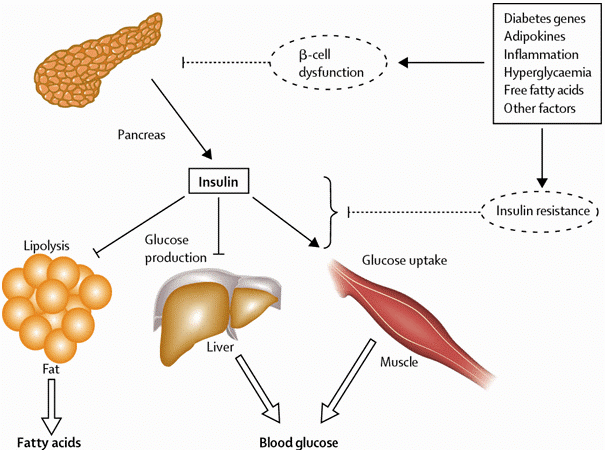The Discovery og Insulin and the Eternal Flame of Hope
Syllabus:
GS 3:
- Science and technology – Development and its application in everyday live.
- Life Science, diseases and their management
Why in the News?
November 14, observed as World Diabetes Day, commemorates Sir Frederick Banting’s birth anniversary and his pioneering role in the discovery of insulin, a transformative medical breakthrough.
What is Diabetes?
- Chronic condition: Diabetes is a long-term illness where the pancreas fails to produce insulin, or the body cannot use it effectively.
- Insulin role: Insulin, a hormone, regulates blood glucose levels to maintain energy and metabolic balance.
- Hyperglycemia: Ineffective insulin usage causes elevated blood glucose, leading to hyperglycemia and related health issues.
- Organ damage: Prolonged high glucose levels damage organs and tissues, affecting their normal functioning.
- Serious complications: Diabetes is a leading cause of blindness, kidney failure, heart attacks, strokes, and lower limb amputations globally.
Role of Hormones and Insulin
- Hormonal messengers: Hormones, produced in minute quantities, regulate distant organs and tissues, ensuring bodily functions operate smoothly.
- Endocrine vs Nervous system: Unlike neurons, endocrine glands transmit instructions across the body without a physical network.
- Pancreas uniqueness: It acts as both an endocrine and exocrine organ, pivotal in maintaining blood sugar levels through insulin.
- Diabetes history: Ancient civilizations noted diabetes symptoms like sweet urine, but it wasn’t understood until the 19th century.
- Key discoveries: Paul Langerhans (1869) identified pancreatic islets, while Oskar Minkowski (1889) linked the pancreas to sugar regulation.
Breakthrough at the University of Toronto
- Banting’s idea: Sir Frederick Banting pursued research on pancreatic secretions regulating carbohydrate metabolism after World War I.
- Team efforts: Collaborating with John Macleod, Charles Best, and James Collip, Banting isolated and purified insulin for medical use.
- First patient: In 1922, Leonard Thompson, a diabetic teenager, became the first to receive insulin therapy, marking a medical milestone.
- Nobel recognition: Banting and Macleod received the 1923 Nobel Prize, but shared it with Best and Collip amid recognition disputes.
- Patent rights: Banting sold the insulin patent for $1 to ensure affordability and widespread production of the life-saving treatment.
Technological Advances in Insulin Production
- Early challenges: Initial insulin was extracted from animals, causing allergic reactions and limiting scalability.
- Recombinant DNA: The 1980s revolutionized production using Escherichia coli, enabling mass manufacturing of human-like insulin.
- Cost efficiency: Recombinant techniques ensured that insulin production met the rising demand globally, maintaining affordability.
- Improved purity: Advances in biotechnology enhanced safety and efficacy, addressing earlier issues with impure extracts.
- Global accessibility: Insulin has become a universally available treatment, extending quality of life for millions with diabetes.
Significance of the Flame of Hope
- Symbolic flame: Lit in 1989 in Canada, the flame honors Banting’s contribution to insulin discovery and his impact on diabetes treatment.
- Global inspiration: The flame symbolizes hope for a diabetes cure, serving as a beacon for ongoing research efforts.
- Human resilience: Banting’s discovery transformed diabetes from a fatal disease to a manageable condition, offering near-normal lives to patients.
- Commitment to cure: The flame remains lit until a definitive cure for diabetes is found, highlighting continued scientific dedication.
- Banting’s vision: His humility and altruism, including the $1 patent sale, underscore his legacy of advancing human welfare.
Challenges
- Diabetes prevalence: Increasing cases of both Type 1 and Type 2 diabetes globally strain healthcare systems, demanding enhanced prevention and management strategies.
- Access and affordability: Despite technological advances, insulin remains inaccessible or costly for millions in low-income countries, worsening health inequalities.
- Insulin dependence: Reliance on insulin is not a cure but a lifelong treatment, requiring constant blood sugar monitoring and adherence to strict medical regimes.
- Complications: Poor diabetes management leads to severe complications such as cardiovascular diseases, kidney failure, and vision loss, adding to societal and economic burdens.
- Research gaps: Progress in developing a diabetes cure remains slow, with limited breakthroughs in addressing underlying autoimmune causes of Type 1 diabetes.
Way Forward
- Technological innovation: Invest in advanced treatments, including artificial pancreas systems and smart insulin, to improve diabetes care and reduce patient dependence.
- Affordable solutions: Expand global access to low-cost insulin through subsidies, international collaborations, and local manufacturing in low-income regions.
- Awareness programs: Promote public awareness of diabetes prevention through education campaigns, healthy lifestyle advocacy, and early detection initiatives.
- Research funding: Strengthen funding for scientific research targeting root causes of diabetes and novel approaches like gene therapy.
- Policy integration: Develop integrated healthcare policies ensuring accessible, equitable, and comprehensive diabetes management services at national and global levels.
Conclusion
The discovery of insulin revolutionized diabetes treatment, transforming countless lives. Sir Frederick Banting’s legacy, marked by the Flame of Hope, inspires ongoing research to find a permanent cure for diabetes.
Mains Practice Question
Evaluate the impact of the discovery of insulin on global healthcare. Discuss the challenges in diabetes management and the role of modern biotechnology in addressing them.




